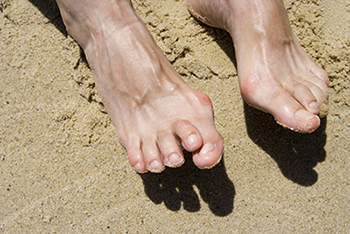Hammertoes are common where one or more toes become bent at the middle joint, leading to discomfort, foot pain, and difficulty walking. Fortunately, surgery is not always necessary to treat hammertoes. Non-surgical treatments such as physical therapy, orthotic devices, toe splints, and proper footwear can manage and even reverse the condition. Early intervention is key, as it can prevent the condition from worsening and reduce the need for surgical correction. If you are experiencing hammertoe symptoms, seek treatment from our Houston podiatrist to help you explore conservative treatment options.
Physical Therapy for Hammertoes
Physical therapy plays a role in the early stages of the non-surgical treatment of hammertoes. A podiatrist may recommend exercises to strengthen and stretch the muscles and tendons. These exercises improve the flexibility of the affected toe and reduce the tightness that causes the joint to bend. Common exercises include toe stretches, towel curls, and marble pickups, which help realign the toe and restore normal function. A consistent physical therapy routine, overseen by the podiatrist, can gradually alleviate pain and discomfort while preventing further deformity.
Orthotic Devices for Hammertoes
Orthotic devices are effective non-surgical treatment options for hammertoes. Custom-made orthotics are tailored to your foot shape and provide much-needed support to relieve pressure on the affected toe. These devices work by redistributing weight across the foot, reducing friction and irritation in the hammertoe area. In addition, orthotics can help correct the alignment of your toes and reduce the likelihood of worsening the deformity. Podiatrists at DeNiel Foot and Ankle Center carefully assess each patient’s foot mechanics to determine the orthotic solution for their condition. This personalized approach ensures that the orthotics not only address hammertoes but also promote foot health.
Toe Splints for Hammertoes
Toe splints are a non-surgical option for straightening hammertoes. These devices gently realign the toe, keeping it in a natural position. They are effective for flexible hammertoes, where the toe can be moved straight. They can be worn throughout the day or during certain activities to minimize discomfort and prevent the condition from progressing. A podiatrist may recommend a toe splint alongside other treatments, such as physical therapy and orthotic devices, to achieve the best results.
The Importance of Proper Footwear
Wearing the appropriate footwear is essential when managing hammertoes. Tight, narrow shoes and high heels can aggravate the condition by putting excessive pressure on the toes. Instead, choose shoes with a wide toe box and adequate arch support to reduce the strain on your feet. The podiatrist can guide you in selecting appropriate footwear, as part of a non-surgical treatment plan.
Early Intervention is Key
Non-surgical treatments for hammertoes are effective when the condition is caught early. If left untreated, hammertoes can become rigid and difficult to correct without surgery. That is why it is crucial to seek professional help at the first sign of discomfort. By consulting a podiatrist early, explore non-invasive solutions that alleviate pain and prevent further damage. Our Houston podiatrist at DeNiel Foot and Ankle Center can help you determine the best course for treating hammertoes without surgery, ensuring you stay active and pain-free.





Comments